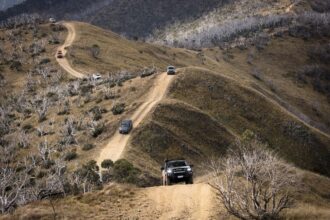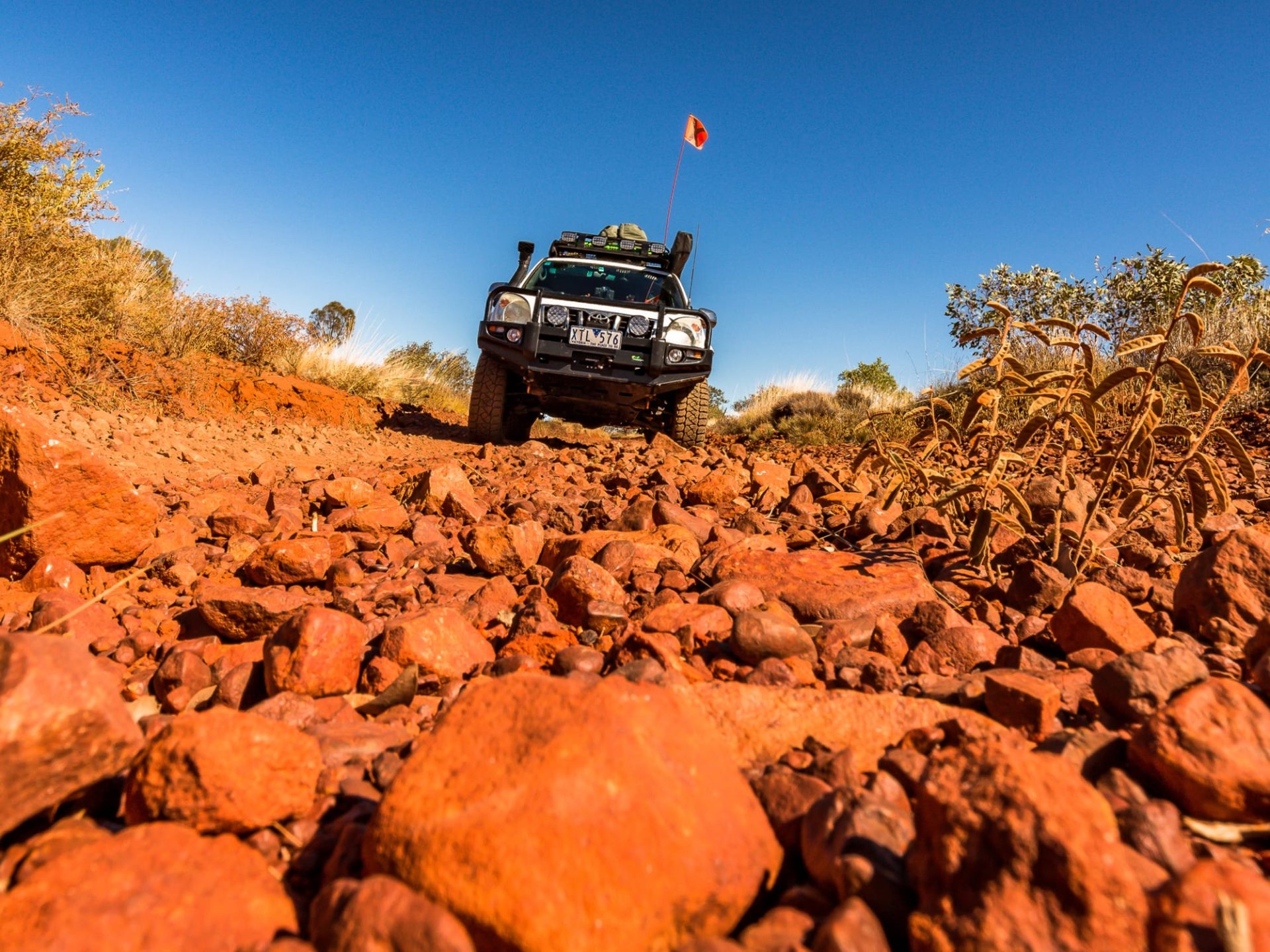For the full story CLICK HERE
Writing about the Kimberley, it’s hard not to feel like a cliché factory. Ragged red mountain ranges, crystal clear waterholes, last frontiers – the whole shemozzle. But for the four-wheel drive tourer the Kimberley is all that – and much more.
Sometimes, first-timers to new 4X4 destinations get slightly disappointed by parts of the journey. Cape York travellers might complain about the lengthy and sometimes boring transport stages. But I’m yet to hear a single complaint about the Kimberley. Sure, it’s huge, but it really does impress and inspire you in an unexpected way. Just when you think you know the region, it will surprise you. So here are my tips for your first drive into Western Australia’s Kimberley.
THE GIBB RIVER ROAD
It really is the only way to see the most remote (read: the best!) parts of the Kimberley. In times gone by, the Gibb River Road used to be a treacherous track, with awful corrugations. Yet with more traffic and more tourists, the locals have widened the road and generally improved the surface the entire way. There are still tight corners that might catch a speeding driver, and corrugations do certainly exist, but the conditions have seriously improved. In fact, you’ll find no need for low range through your entire journey. Offshoots from the Gibb River Road are where you will need to take things more seriously, and the road out to Kalumburu and Mitchell Falls is certainly one of those. The road quickly changes from 100km/h super-highway to rutted water crossing within the space of metres, and it’s easy to cause your vehicle damage. The key here is to keep speeds down, and be prepared for the unexpected.
CAN I TAKE MY CAMPER TRAILER TO THE KIMBERLEY?
The bulk of the Kimberley sits on shallow, rocky soils, and this provides a solid base for all vehicles, so towing a camper trailer is a breeze in most locations. The only exception is on the soft sandy tracks heading out to the northern coastline.
On my last journey up to Kalumburu we were on one of these single lane sandy tracks out to the coastline and came upon a camper trailer coming the other way. We tried hard to pull off to the side, but the soft sand made it hard to do. The oncoming 4X4 and camper-trailer had to stop, and when they tried to drive again they bogged down. We gave them a quick recovery snatch, but that gives you some idea of how you might get stuck. Likewise, some of the beaches around Cape Leveque on the west coast also feature similar soft sand.
MOST UNEXPECTED SIGHT
You make your way out to these remote locations, and you certainly don’t expect to see a fleet of helicopters – all five of them – sitting there waiting! There were no toilets and barely any facilities, yet you could pay with your credit card for a short or long joy flight over Mitchell Falls. Handy if you’ve got a film crew in tow and want to get some aerial shots!
The flight over Mitchell Falls does give you a brilliant perspective, and for a few extra dollars they’ll fly you over the Kimberley coastline. It’s a fun experience, but certainly not what I’d call essential viewing.
And speaking of Mitchell Falls, be sure to take your swimmers as the walk out there is inevitably hot and steamy. And don’t forget your water bottle either – you’ll drain it by the time you get back.
BEST FREE TOURIST EXPERIENCE
This is a tough one. Bell Gorge is one of those locations that makes you feel like you’ve really made it to the Kimberley. It is remote, it is spectacular, and you can grab a swim while you’re there. Sure, it would be nice if the carpark was a little closer, but that helps keep the waterhole in pristine condition. The waterhole itself is obvious, but take some time to explore the area up the gorge for some even more private oases.
And the other Kimberley classic experience is the sun setting on the west coast. Everyone has heard about the Cable Beach sunsets, but for a less crowded experience, try those at Cape Leveque. During certain times of the year you’ll be lucky enough to see the ‘Staircase to the Moon’, where the full moon reflects off the calm ocean to create a visual staircase right into the sky.
BEST PAID TOURIST EXPERIENCE
Most people only get to the Kimberley once or twice in their lives, and there are some places that even a 4X4 can’t access. I climbed aboard a seaplane at Derby on a tour to the Horizontal Falls on the northern coastline. The seaplane ride itself was spectacular, as we ventured out over an amazingly picturesque coastline. We then landed on a remote inlet, and jumped in an oversized inflatable boat, powered by twin 300hp engines.
The waterfalls here are a unique phenomenon, where a crack in two rock formations traps massive tidal water flows. Whether on an incoming or outgoing tide, the water turns into a horizontal waterfall, and you can ride straight over the falls in the boat. It’s an incredible experience, and far more fun than I would have imagined. But the tour doesn’t stop there. You’ll also get a boat tour around the waterways, you’ll go croc-spotting and you will even visit an elevated reef. I’d explain it, but it has got be seen to be believed.
FRESHWATER CROC EXPERIENCE
Windjana Gorge is literally loaded with freshwater crocodiles. These are the ones that only have a hunger for fish, not humans, so they’re considered a lot safer than their saltwater brethren. But given their massive concentration at Windjana Gorge, I wouldn’t bother heading in for a dip. You would be likely to get an accidental nip for sure. The bushwalk to Windjana is excellent, as you pass through cracks in rocks, however, beware as the tour buses have found this place. Best to visit early morning or late afternoon if you want to experience some serenity with the local lizards.
BEST BEACH
Lombadina – write that name down! It’s a beautiful little aboriginal community, and then you pop put onto the one of the most beautiful white sandy beaches in Australia. You’ll find it at Cape Leveque, and provided the cycles have been behaving themselves, there’s a beautiful thatched roof shade shelter that looks like it could be in the Caribbean, not the coast of WA. Just be sure to get permission to drive on the beach from the local community office (you’ll find it – there’s just the one!).
EL QUESTRO STATION OR HOME VALLEY?
Given their proximity to each other, many travellers feel the need to choose where they should stay – El Questro Station or Home Valley Station. Having stayed at both, I’d recommend you do too. El Questro is certainly a more ‘polished’ resort experience, as it sees more tourists and offers everything from tent sites up to serious boutique accommodation. And its natural wonders like palm fringed pools and massive gorges are unbelievably impressive. There are tracks to drive on around the station, some of which are 4X4 only. So El Questro to me is a certain starter for the Kimberley first-timer.
Home Valley Station, being a working cattle station, is closer to its station roots. Everyone dines together in the big open-walled dining area (the Dusty Bar & Grill), and it’s a great feed indeed. And throughout the day, you can experience natural horsemanship displays and horse trail rides.
ROAD CONDITIONS
While the mighty Gibb River Road used to be a torturous test of damage-inflicting corrugations, it’s not as bad as it used to be. Sure, being dirt, it does still suffer from heavy traffic and poor weather, but you can drive a lot of it at between 80 and 100km/h. And the worst bits through mountains have even been painted with a coating of bitumen. But the side roads, those exits out to the coast and even up to Cape Leveque are more of a challenge. The road north to Kalumburu starts out easy enough, but is punctuated by unexpected washaways and slender creeks, which if taken too rapidly could inflict some real damage. The road to Mitchell Falls also needs to be taken slowly and with care, though at the right speeds it doesn’t represent any issues. North of Kalumburu and out to the coastline the tracks become slow going and soft and sandy. For the lone vehicle it’s an easy run, but it’s more of a challenge if you’ve got a camper trailer or off-road caravan in tow. Dump those tyre pressures down sooner rather than later, or you could be dragging out the winch!
WHEN TO GO
June through to September is the best time to visit the Kimberley. Then you’ll have comfortable night temps, and beautiful warm days (28-32). Any earlier, it could be too wet, and any later, too hot. I’ve been there in late September and in the middle of the Kimberley experienced 460C temps daily. It cools down on the coast, but also becomes more humid and around 320C.
By Pat Callinan. Images by Tommy Salmon









